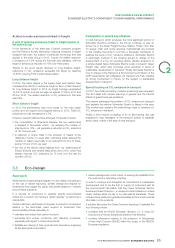APC 2012 Annual Report Download - page 57
Download and view the complete annual report
Please find page 57 of the 2012 APC annual report below. You can navigate through the pages in the report by either clicking on the pages listed below, or by using the keyword search tool below to find specific information within the annual report.
2012 REGISTRATION DOCUMENT SCHNEIDER ELECTRIC 55
SUSTAINABLE DEVELOPMENT
2
GREEN AND RESPONSIBLE GROWTH DRIVING ECONOMIC PERFORMANCE
StruxureWare, Schneider Electric provides market leading software
solutions.
Customers are now able to more effectively connect their
sustainability goals to tangible actions, through streamlined
software tools and interfaces. Customers have strongly validated
the company’s approach, and one recent independent analyst
report identifi ed StruxureWare software as a leader, with the
strongest momentum among all competitors.
Finally, Schneider Electric is rolling out an EcoXperts network in
many countries to provide its smaller customers with simple and
competitive solutions for energy effi ciency and energy source
integration. These are specialised external partners trained and
supported by the Group to develop close working relationships with
their customers at a local level.
This network is already in place in France, Spain and Italy; it is
developing in the United States and in about ten countries, in
Europe and Latin America. A key performance indicator has
been included in the Planet & Society Barometer 2012-2014: to
exceed by 7points the Group growth revenues with the EcoXperts
activities. In 2012, the target has been achieved: the EcoXperts
growth revenues are 7.6points above the Group growth revenue in
the countries where the program is deployed.
The Smart Grid
Context
The smart grid combines electricity and IT infrastructure to integrate
and inter-connect all users (producers, operators, marketers,
consumers etc.) in order to continue to effi ciently balance demand
and supply over an increasingly complex network.
Today’s grid is undergoing rapid change: the Fukushima tragedy has
led many countries to rethink their energy strategy and evolve their
energy mix; renewable energy sources are enjoying a fast growth,
although they remain a small share of total energy produced;
electric vehicles are expecting stronger government support to their
deployment.
This is making the smart grid more essential than ever, and boosting
development of specifi c applications in every region.
Offers
Schneider Electric supports and connects the key domains of a
smarter grid: on the supply side, fl exible distribution and smart
generation, which covers bulk generation, distributed generation
and renewable energy integration; on the demand side, effi cient
homes and effi cient enterprise, which covers homes, buildings,
industrial facilities & datacenters, as well as electric vehicles
charging infrastructure; and fi nally, balancing supply and demand,
through demand response.
Schneider Electric offers products and solutions in all these
domains:
•fl exible distribution: control and automation of sub-stations
(between high and medium voltage and medium and low voltage
networks), SCADA (Supervisory Control And Data Acquisition),
protection and metering systems, outage devices;
•smart generation: installation and equipping of solar, wind or
hydroelectric plants, automation and control systems, SCADA,
engineering and maintenance.
According to the International Energy Agency’s World Energy
Outlook 2012, renewable energy sources could grow from 13%
of total energy production in2010 to 18% in2035 – representing
an 83% increase.
Schneider Electric serves and connects power plants and large
buildings to the electricity grid, provides equipment to turbine
manufacturers and supplies the residential market through its
network of partners and distributors;
•e ffi cient homes and enterprise: energy effi ciency products and
solutions, complex solutions for integrated energy management,
operational and fi nancial project management.
SchneiderElectricalso offers safe recharging infrastructures for
electric vehicles, as well as effi cient energy management systems
and high added value accompanying services.
The recharging infrastructure must be completely safe, for the
user as well as for the vehicle, the building and the electricity grid.
Our range of solutions covers residential or co-owned garages,
public and private car parks or roadside parking as well as rapid
recharging infrastructures.
However, for an electric vehicle to be “green”, the electricity
used for charging must also be green. Priority for charging must
therefore be given to the periods in which energy sources with low
CO2 emissions are available. Peak periods must also be avoided
as the electricity grid is already experiencing very high demand
for all other uses. This is why Schneider Electric is developing
energy management solutions adapted to grid cycles.
Finally, the variety of charging environments, whether public or
private, single or collective, requires information and invoicing
systems to be put in place for businesses and car service
providers;
•demand-response: consultancy and implementation of software
platforms to share data and for load shedding aimed at energy
operators.
Sustainable Cities
Context
Cities are where the world’s sustainability battle will be won –or lost.
Cities need to ensure resource effi ciency over the long-term as well
as social inclusiveness, while providing more effi cient urban services
to their constituents.
As cities improve the effi ciency of their underlying urban systems
(electricity distribution, gas distribution, water distribution, public and
private transportation, buildings and homes, waste management),
they increase the performance of the public services they provide,
thus improving their liveability and attractiveness to residents,
commuters and visitors alike.
























